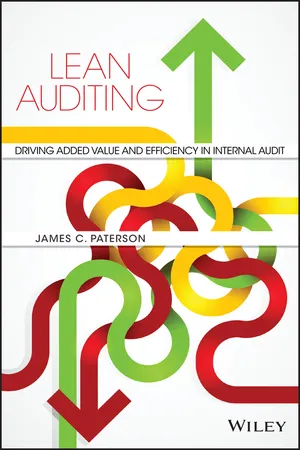
- English
- ePUB (mobile friendly)
- Available on iOS & Android
About This Book
"How can you argue with the core principles of Lean, that you focus on what provides value to your customer and eliminate work that is not necessary (muda)? Internal auditors need to understand not only who their primary customers are, but what is valuable to them - which in most cases is assurance that the risks that matter to the achievement of objectives are properly managed. We need to communicate what they need to know and not what we want to say. This incessant focus on the customer and the efficient production of a valued product should extend to every internal audit team. How else can we ensure that we optimize the use of our limited resources to address the dynamic business and risk environment within which our organizations operate?"
Norman Marks, GRC Thought Leader
Using lean techniques to enhance value add and reduce waste in internal auditing Lean Auditing is a practical guide to maximising value and efficiency in internal audit through the application of lean techniques. It is an ideal book for anyone interested in understanding what progressive, value adding audit can be like. It is also ideal for anyone wondering whether audit activities can be streamlined or better co-ordinated with other activities.
The book contains practical advise from the author's experience as CAE of AstraZeneca PLC; from his work as a consultant specializing in this field; as well as insights from leading CAEs in the UK, US and elsewhere. In addition, there are important insights from thought leaders such as Richard Chambers (IIA US) and Norman Marks (GRC thought leader) and Chris Baker (Technical Manager of the IIA UK).
Increasing pressure on resources is driving a need for greater efficiency in all areas of business, and Internal Audit is no exception. Lean techniques can help streamline the workflow, but having only recently been applied to IA, lack the guidance available for other techniques. Lean Auditing fills this need by combining expert instruction and actionable advice that helps Internal Auditors:
- Benchmark their efficiency against lean ways of working
- Understand warning signs of waste and lower added value
- Understanding practical ways of working that improve added value and reduce waste
- Gain confidence about progressive ways of working in internal audit
- Understand how improved ways of working in audit can positively impact the culture of the wider organization
One of the keys to the lean audit is finding out exactly what the stakeholder wants, and eliminating everything else. Scaling back certain operations can delineate audit from advisory, and in the process, dramatically improve crucial outcomes. To this end, Lean Auditing is the key to IA efficiency.
Frequently asked questions
PART 1
Lean and Lean Auditing in Overview
1
Lean Auditing at AstraZeneca
References and Other Related Material of Interest
- Paterson, J. (2007) Business partnership redefined, Audit Director Roundtable. AstraZeneca case study
- Paterson, J. (2008) Internal audit for the 21st century. IIA Scotland
- Paterson, J. (2009) Internal audit: the times they are a changing. Chartered Institute of Management Accountants
- Paterson, J. (2009) Future developments in internal audit. IACON
- Paterson, J. (2012) Giving assurance IIA UK. Heads of Internal Audit Service
- Paterson, J. (2012) Developing an effective audit strategy. IIA UK Head of Audit Service
2
A Brief History of Lean, Notable Principles and the Approach Taken by this Book
ORIGINS OF LEAN AND THE BENEFITS IT DELIVERS
- Required less investment for a given production capacity;
- Went from concept to delivery with less time and effort;
- Delivered products with fewer defects.
- The machine that changed the world by Womak, Jones and Roos, that gave an account of the techniques employed by Toyota and other Japanese manufacturers and demonstrated the superior performance of this approach;
- Lean Thinking by Womak & Jones, which sets out the key principles of lean and also noted the successes of a number of other organizations in the US and Europe as a result of implementing lean techniques.
- Reductions in: defects, lead times, cost, inventory and waste;
- Improvements in: customer satisfaction, productivity, capacity, responsiveness and quality.
KEY LEAN PRINCIPLES, TOOLS AND TECHNIQUES
The Five Key Principles of Lean
Specify Value from the Point of View of the Customer
Identify the Value Stream
Flow
Table of contents
- Cover
- Titlepage
- Copyright
- Dedication
- Foreword
- Introduction
- PART 1 LEAN AND LEAN AUDITING IN OVERVIEW
- PART 2 LOOKING AT INTERNAL AUDIT PLANNING AND ASSIGNMENT DELIVERY
- PART 3 LOOKING AT KEY UNDERPINNING CAPABILITIES, PROCESSES AND WAYS OF WORKING
- PART 4 FINAL REFLECTIONS
- Other Recommended Reading
- Appendix – Illustrative Kano Analysis Regarding Internal Audit
- Closing Dedication & Thanks
- Index
- End User License Agreement